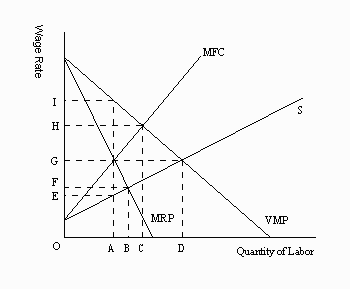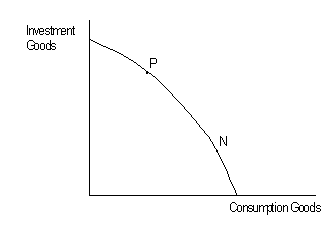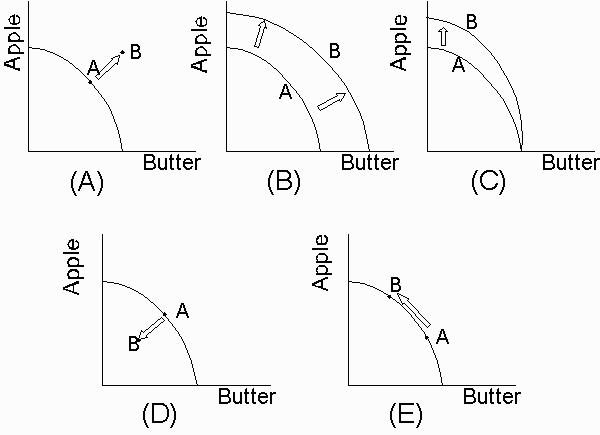Economics 165 Final Exam
Spring 1999
- 1. To an economist, a good is scarce when:
- a. the amount of the good available is less than the amount that people want
when the good's price equals zero
- b. the amount of the good available is greater than the amount that people
want when the good's price equals zero
- c. resources must be used to produce the good
- d. the economic questions of what, how, and for whom to produce, cannot be
answered by the economy involved
-
- 2. "More jobs should be made available to teenagers." This is an example of
- a. a normative statement
- b. a positive statement
- c. an assumption
- d. a hypothesis
-
- Use the Following Graph to Answer Question 3
-
-
-
- 3. According to the graph above, other things being equal, society's current
choice of point P on the frontier will:
- a. allow it to achieve more rapid economic growth than would the choice of
point N
- b. entail a slower rate of economic growth than would the choice of point N
- c. entail the same rate of growth as would the choice of point N
- d. be unobtainable because it exceeds the productive capacity of the economy
-
- Use the Following Graph to Answer Question 4
-
- 4. Assume that an economy is producing only two goods: apples and butter. Suppose
that a new fertilizer is invented which greatly increases the productivity of
apple trees. From the figures above, choose the one which best illustrates
the change in the production possibilities caused by this increased productivity,
all other things unchanged.
- a. (A)
- b. (B)
- c. (C)
- d. (D)
- e. (E)
-
- 5. Which of the following would result in an increase in the supply of good A?
- a. An increase in the price of A's substitute
- b. An increase in the prices of resources used to produce good A
- c. Technological advancement applicable to the production of A
- d. A reduction in the price of A
-
- 6. If an increase in the price of good X causes the demand for good Y to decrease,
it can be concluded that
- a. X and Y are substitutes
- b. X and Y are complements
- c. X and Y are inferior goods
- d. X and Y are superior goods
- e. there is collusion in the market place
-
- 7. Substitution and income effects of a change in the price of a good may help
explain the
- a. direct relationship between income and demand
- b. direct relationship between price and quantity supplied
- c. direct relationship between price and quantity demanded
- d. inverse relationship between price and quantity demanded
-
- 8. Which of the following is correct with respect to equilibrium in a free market?
- a. free markets are always in equilibrium
- b. once attained, the equilibrium point never changes
- c. the equilibrium price is the price that equates quantity demanded with
quantity supplied
- d. the quantity traded at equilibrium is the difference between the quantities
demanded and supplied
-
- 9. A government-imposed price floor in a particular market typically
- a. results from collusion
- b. causes an increase in demand
- c. causes an increase in supply
- d. results in a surplus of the good
-
- 10. The price elasticity of demand, for a given product, indicates:
- a. how far businessmen can stretch their fixed costs
- b. the degree of competition in a market
- c. the extent to which a demand curve shifts as incomes change
- d. how responsive is quantity demanded to price changes
-
- 11. If the income elasticity of demand for Drewry's beer is zero, then if income
rises, people tend to
- a. spend less on Drewry s beer
- b. spend more on Drewry's beer
- c. spend the same on Drewry's beer
- d. substitute Corona beer for Drewry's beer
-
- 12. The law of diminishing marginal utility:
- a. suggests that total utility will eventually decrease if enough of the good
is consumed
- b. suggests that as a consumer buys more of a good, its price will drop
- c. provides an explanation for perfectly elastic demand curves
- d. suggests that as a individual's consumption of a good increases, his
marginal utility must eventually decrease
-
- 13. Utility refers to
- a. a shift in the demand curve for a good
- b. a decline in the supply of a good
- c. the satisfaction a consumer receives from consuming a good
- d. the usefulness of a good
-
- 14. The exchange rate is:
- a. the dollar price of an ounce of gold
- b. total exports divided by total imports
- c. the price of one country's currency expressed in terms of another country's
currency
- d. the ratio of the value of total imports to the value of total exports
-
- 15. Imposition of a U.S. tariff on imported shoes:
- a. benefits consumers in the United States by guaranteeing a high-quality
product
- b. benefits domestic shoe producers by eliminating competitors
- c. harms foreign consumers of shoes by decreasing the amount of shoes
available for their consumption
- d. harms U.S. shoe workers
-
- 16. A firm's total cost
- a. is always constant
- b. is always zero when the firm produces nothing
- c. includes only monetary costs to the firm
- d. is equal to the sum of implicit and explicit costs
-
- 17. In the short run, if average variable costs equal $6 and average total costs
equal $10 and output equals 100, then total fixed costs equal:
- a. $4
- b. $400
- c. $16
- d. $1,600
- e. $0.025
-
- 18. The addition to total variable cost when one more unit of output is produced is
called
- a. total cost
- b. marginal cost
- c. fixed cost
- d. average variable cost
-
- 19. A young chef is considering opening his own restaurant. To do so, he would have
to quit his current job at $20,000 a year and take over a store building he owns
that currently rents for $6,000 a year. To run the restaurant he would have to
pay $50,000 for food and $2,000 for gas and electricity. What are his implicit
costs?
- a. $26,000
- b. $60,000
- c. $78,000
- d. $52,000
- e. $72,000
-
- 20. The long-run average cost curve:
- a. will always be horizontal or falling throughout
- b. is derived by adding horizontally the Average Cost curve of each firm
- c. is derived by adding horizontally the Marginal Cost curve of each firm
- d. shows the minimum costs of production for each level of output
-
- 21. Marginal revenue is
- a. 1 minus marginal cost
- b. total revenue divided by total cost
- c. explicit revenue minus implicit revenue
- d. the change in total revenue associated with selling an additional unit of a
good
-
- 22. The demand curve for a perfectly competitive firm
- a. has a price elasticity coefficient of less than 1
- b. is perfectly inelastic at the market price
- c. is the same as the market demand curve for the entire industry
- d. is perfectly elastic at the market price
-
- 23. If a perfectly competitive firm is producing 1000 units, earning a total revenue
of $3000, incurring a marginal cost of $2, and earning a positive economic
profit, the firm
- a. is maximizing profit
- b. could increase profit by increasing output
- c. could increase profit by decreasing output
- d. could sell more units if it would decrease its price
-
- 24. For a perfectly competitive firm, the short-run supply curve is
- a. the rising section of the marginal cost curve
- b. the entire marginal cost curve
- c. the rising part of the average total cost curve
- d. the marginal cost curve above the average variable cost curve
- e. the marginal cost curve above the average total cost curve.
-
- 25. If the firms in an industry produce where price equals marginal cost and there is
free entry and exit then, in the long-run, there will be
- a. allocatively efficient production and a zero economic profit
- b. positive economic profit
- c. zero accounting profit
- d. an economic loss
-
- 26. In a perfectly competitive, constant cost, industry
- a. the long-run market demand curve will be upward sloping
- b. the long-run market demand curve will be perfectly elastic
- c. the long-run market supply curve will be perfectly elastic
- d. the long run market demand curve will be perfectly inelastic
-
- 27. If a monopoly desires to maximize its profits, it should produce where:
- a. price equals marginal revenue
- b. the difference between price and marginal cost is at its maximum
- c. price equals average cost
- d. marginal cost equals marginal revenue
- e. price equals average variable cost
-
- 28. Assume that at the current output level a monopolist is breaking even (economic
profit equals zero), has a marginal revenue of $7, and a marginal cost of $4.
Which of the following statements is correct?
- a. The firm is producing the profit-maximizing output
- b. The firm could increase its profit by increasing its price
- c. The firm could increase its profit by increasing its output
- d. The firm could increase its profit by decreasing its output
-
- 29. A monopolistically competitive firm's demand curve is downward sloping because
- a. other firms are free to enter the market
- b. there are a large number of firms in the market
- c. product differentiation gives the firm some control over price
- d. the firm sells a homogeneous product
-
- 30. When a monopolistically competitive firm is in long-run equilibrium, it is:
- a. technologically (productively) inefficient since it produces an output
smaller than the one which would minimize its average costs of production
- b. allocatively inefficient since it produces where its price exceeds its
marginal cost
- c. making a zero economic profit
- d. all of the above are true
-
- 31. "Mutual Interdependence" means that
- a. pricing actions of rivals in the market are of no consequence to a single
firm
- b. each firm in the market makes differentiated products
- c. each firm in the market makes homogeneous products
- d. a single firm will consider reactions of rivals to any action the single
firm takes
- e. the demand curves of the firm and the market are identical
-
- 32. One practice that allows oligopolists to coordinate their pricing behavior
without colluding is
- a. game theory
- b. differential pricing
- c. price leadership
- d. independence
-
- 33. If a firm which is unable to price discriminate is faced with a downward sloping
demand curve:
- a. its marginal revenue curve equals its price
- b. its most profitable output is where marginal cost equals price
- c. its supply curve is its marginal cost curve above its average variable cost
curve
- d. its marginal revenue curve is less than its price
-
- 34. Which of the following is a false statement? Imperfect competition implies that
in the long run
- a. the firm may not produce at its minimum average total cost
- b. price may be greater than marginal revenue
- c. the firms demand curve is not horizontal
- d. price is equal to marginal cost
-
- 35. As labor costs account for a larger portion of total costs, demand for labor
becomes
- a. less elastic
- b. more elastic
- c. perfectly elastic
- d. perfectly inelastic
-
- 36. An increase in the market demand for labor will cause:
- a. the level of employment to fall
- b. the wage rate to fall
- c. the supply of labor to rise
- d. the wage rate to rise and the quantity of labor employed to rise
-
- 37. A firm which is perfectly competitive in both its output and labor market should
hire an additional worker if
- a. total revenue is less than total cost
- b. marginal revenue product is less than the wage rate
- c. marginal product would be decreased
- d. marginal product would be increased
- e. marginal revenue product is more than the wage rate
-
- 38. In a perfectly competitive labor market, the supply curve of labor faced by the
individual firm is
- a. perfectly inelastic at the market wage
- b. equal to the market wage
- c. given by the value of the marginal product (VMP) of labor curve
- d. the upward sloping portion of the marginal factor cost (MFC) of labor curve
-
- 39. Which of the following will not be helpful to workers seeking higher wages from
the management of industry X?
- a. the demand for good X is highly price-inelastic
- b. total labor costs represent less than 10 percent of the total costs of
producing product X
- c. the labor market is characterized as a monopsony
- d. the workers have monopoly power in the labor market
-
- Use the Following Graph to Answer Question 40

- 40. The firm in the diagram above will hire ____ workers.
- a. 0-A
- b. 0-B
- c. 0-C
- d. 0-D
 Back to the Final Exam Listings
Back to the Final Exam Listings



